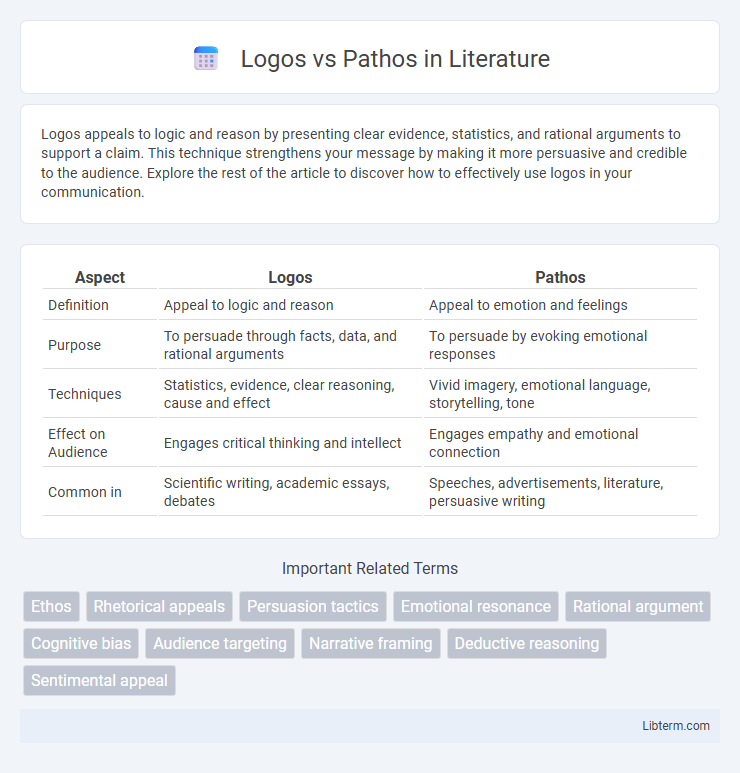Logos appeals to logic and reason by presenting clear evidence, statistics, and rational arguments to support a claim. This technique strengthens your message by making it more persuasive and credible to the audience. Explore the rest of the article to discover how to effectively use logos in your communication.
Table of Comparison
| Aspect | Logos | Pathos |
|---|---|---|
| Definition | Appeal to logic and reason | Appeal to emotion and feelings |
| Purpose | To persuade through facts, data, and rational arguments | To persuade by evoking emotional responses |
| Techniques | Statistics, evidence, clear reasoning, cause and effect | Vivid imagery, emotional language, storytelling, tone |
| Effect on Audience | Engages critical thinking and intellect | Engages empathy and emotional connection |
| Common in | Scientific writing, academic essays, debates | Speeches, advertisements, literature, persuasive writing |
Understanding Logos: The Power of Logic
Logos is the persuasive appeal based on logic and reason, utilizing facts, statistics, and clear evidence to support an argument. Mastering logos enhances critical thinking and enables the construction of coherent, rational messages that resonate with analytical audiences. Effective use of logos increases credibility and helps to systematically dismantle opposing viewpoints by emphasizing objective truth.
Defining Pathos: The Influence of Emotion
Pathos appeals to the audience's emotions, aiming to evoke feelings such as empathy, anger, or sadness to influence decision-making and perception. Emotional triggers in speeches or writing can create a strong connection between the speaker and the audience, making the message more persuasive and memorable. Unlike logos, which relies on logic and facts, pathos leverages sentiment to motivate action and reinforce the communicator's intent.
Key Differences Between Logos and Pathos
Logos appeals to logic and reason by using facts, statistics, and clear evidence to support an argument, while pathos targets emotions to persuade the audience through feelings such as empathy, fear, or excitement. Logos relies on structured, rational arguments often found in scientific studies, data, or logical sequences, whereas pathos leverages storytelling, vivid language, and emotional triggers to create a connection with the audience. Understanding these key differences allows communicators to tailor their message effectively by choosing either factual persuasion with logos or emotional influence with pathos.
The Role of Logos in Persuasive Writing
Logos plays a crucial role in persuasive writing by appealing to logic and reason through structured arguments, factual evidence, and clear data. Employing statistics, research findings, and logical deductions enhances the credibility of the message and convinces the audience through rational analysis. Mastery of logos ensures arguments are coherent and compelling, enabling writers to effectively influence critical thinking in readers.
How Pathos Connects With the Audience
Pathos connects with the audience by appealing directly to their emotions, stirring feelings such as empathy, fear, joy, or anger to create a deeper bond with the message. This emotional engagement helps to motivate action or change beliefs more effectively than purely logical arguments. Effective use of vivid stories, relatable scenarios, and emotional language enhances the persuasive power of pathos in communication.
Advantages of Using Logos in Arguments
Logos strengthens arguments by appealing to logic and reason, making claims more credible and persuasive through clear evidence and structured reasoning. Utilizing data, statistics, and factual information enhances audience trust and supports objective analysis. This approach minimizes emotional bias, fostering critical thinking and facilitating informed decision-making.
The Impact of Pathos on Decision Making
Pathos significantly influences decision making by appealing to emotions, which often override logical reasoning in human cognition. Emotional triggers such as fear, happiness, or empathy activate the brain's limbic system, creating powerful motivations for action. Marketers and leaders harness pathos to create compelling narratives that drive consumer behavior and political support more effectively than pure logical appeals.
Balancing Logos and Pathos for Effective Persuasion
Effective persuasion requires balancing logos and pathos to appeal both to reason and emotion. Logos provides logical evidence and factual support that build credibility, while pathos connects with the audience's emotions to foster engagement and empathy. Combining clear data, statistics, and rational arguments with relatable stories and emotional appeals enhances overall communication impact and persuasiveness.
Common Pitfalls When Relying on Logos or Pathos
Overreliance on logos can lead to arguments that appear cold, overly technical, or disconnected from the audience's emotions, reducing persuasive impact. Excessive use of pathos risks manipulation or emotional bias, causing the message to lack credibility and logical foundation. Effective persuasion balances logos and pathos to maintain reasoned arguments enriched with emotional resonance.
Real-World Examples of Logos and Pathos in Action
Logos is evident in climate change debates where scientists present data on rising global temperatures to support policy changes. Pathos appears in charity campaigns using emotional stories of individuals affected by disasters to motivate donations. Corporations combine logos and pathos by showcasing product effectiveness alongside testimonials to persuade consumers.
Logos Infographic

 libterm.com
libterm.com